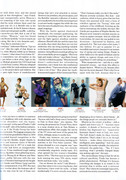Miuccia Prada to present the Turner Prize
Miuccia Prada, one of the most respected and influential fashion designers in the world, and a renowned pioneer of contemporary art, has been selected to announce the winner of the Turner Prize 2010 - the United Kingdom's most publicised and controversial art award.
Ms Prada will anounce the winner during a live broadcast of the award ceremony on Channel 4, on Monday, December 6th.
The four shortlisted artists are Dexter Dalwood, who paints places and situations he has never seen with forensic accuracy, using subject matter such as the death of government weapons expert, Dr David Kelly, and the Charles Manson murders; Angela de la Cruz, whose torn, crumpled canvasses and bits of broken furniture and metal cabinets, suggest deconstruction and human frailty at its most despairing; Susan Philipsz, a Scottish artist known for playing recordings of herself singing over PA systems; and The Otolith Group, whose work explores history, politics, and the essay film. The winner receives £25,000, with £5,000 each to the other short-listees.
The work of the four artists is currently on show at Tate Britain, until January 3rd. The Turner Prize, named after the painter J.M.W.Turner, which began in 1984, represents all media, for visual artists under the age of 50. It has become associated primarily with conceptual art, most notoriously with Damien Hirst's 'Mother and Child Divided', (four tanks containing the severed sections of a cow and calf) which won in 1995, and Tracey Emin's 'My Bed', with stained sheets, knickers and condoms, which was shortlisted in 1999.
Miuccia Prada, the women credited with turning black nylon into the most important fashion statement of the 1980's, with the invention of the 'ugly' fashion aesthetic, and a woman who prizes the psychology of sensuality, is one of the boldest collectors of contemporary art. She and her husband, the dynamic and volatile, Patrizio Bertelli, established Fondazione Prada in 1995, with the aim of presenting "the most radical intellectual challenges in contemporary art and culture." The Fondazione has staged numerous exhibitions, including works by Sam Taylor-Wood, Anish Kapoor, and Marc Quinn, at the Prada HQ on the via Fogazzaro, in Milan - which is also used as a catwalk space for Prada's autumn/winter and spring/summer fashion shows.
Ms Prada was the first to work with ground-breaking architects to set new frontiers in store design, and collaborated with the Pritzker Prize laureates, Rem Koolhaas and Herzog & de Meuron, to create the 'Epicenter' stores in New York (2001), Tokyo (2003), and Los Angeles (2004). One of Prada's most ambitious cultural projects was an installation-gallery-building, called the Prada Transformer, in Seoul, last year.
In 2005, Time Magazine named Miuccia Prada as one of the 100 most influential people in the world for 'having provoked and influenced colleagues for years with her eccentric and highly personal sensibility.'
At her office in Milan, at Prada HQ, the designer can, if she feels like 'slipping out for a moment', literally do exactly that, leaving via a space-age slide - a 'Fifth Element'-style stainless steel funnel which juts out of the floor and spirals down through the brickwork to the courtyard below. The slide is a work of art by the German artist Carsten Höller, who installed five similar slides at the Tate Modern, in 2006.

































